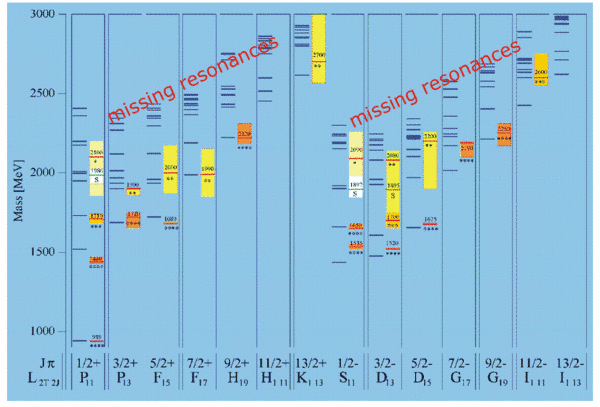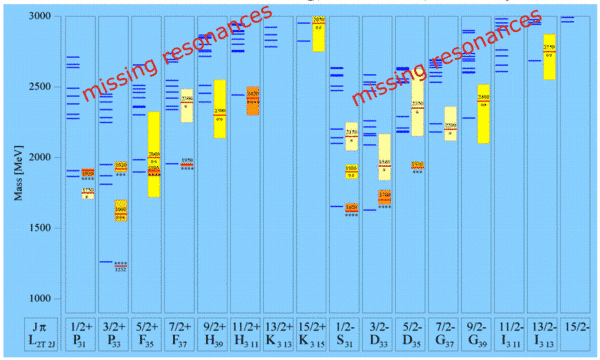Physics at Crystal-Barrel@ELSA
Baryon spectroscopy
Some 50 years ago, the baryons that had been known at the time - protons and neutrons - were considered elementary particles themselves. However, in the years to come, a spectrum of baryonic resonances was discovered. As in optics, the excitation spectra of atoms yield information on the structure of the atom, the excitation spectra of protons and neutrons allow to draw conclusions on what nucleons look like on the inside.
One of the problems one encounters when investigating the internal structure of nucleons is that there is no exact theory of the strong interaction describing the energy region in which hadrons form. At rather large and at very small energies, the strong interaction can be described perturbatively: For large momentum transfers Q2, the coupling constant is small so that the interaction can be treated perturbatively similar to the electromagnetic interaction. At small energies, where the coupling constant is large, chiral perturbation theory provides a tool to describe the interaction by treating the momentum and chiral symmetry breaking perturbatively. However, at intermediate energies where hadronic physics is to be established, αs is in the order of 1, so that now perturbative treatment is possible.
Over the years, theoreticians have developed models of the nucleon. One rather promising ansatz is the description of baryons as systems of so-called constituent quarks. In this picture the nucleon is described by three constituent quarks moving in a confined potential and being subject to a residual interaction. These constituent quarks consist of the bare quarks that are responsible for the properties of the constituent quarks and of the effects these bare quarks have on the surrounding QCD vacuum. Due to the self interaction of gluons and the anti-screening of the color charge one obtains an object composed of a bare quark inside a cloud of gluons and additional quark-anti-quark pairs generated from the vacuum (sea quarks). The mass of the baryon is made up of the interaction mainly. The constituent quark is in a way a container for a QCD quark as shown below: The bare quark lines are girdled by emissions of gluons and generations of quark-anti-quark pairs. The residual interaction takes place between two quark lines.

The difference between the different constituent quark models is the treatment of the residual interaction between the constituents (e. g. Bonn Model: Instanton induced forces).
If we take the proton or neutron consisting of three of these constituent quarks, the method of baryon spectroscopy becomes obvious: We take any quark, lift it to an excited state, and observe the decay of the excited system. For the excitation, we use photons, so that it takes place in electromagnetic interaction rendering the experiment independent of the coupling to any incident hadronic channel. In the final state we observe a proton and any number of photons stemming from the decay of (neutral) mesons. These photons can be combined reversely to give these mesons. Investigating the angular characteristics of these final states allows us to draw conclusions on the properties of the intermediate state of nucleon or Δ resonances that we are interested in, γp -> N* (Δ*) -> pX (where X stands for any number of mesons/photons).
Missing resonances
The spectrum of baryonic resonances has been investigated in different reactions, e. g. NN and πN. γN has yet been investigated by only few experiments to a lesser extent. It is expected that resonances may occur here which have not been observed so far. The coverage with data over the full angular range and the whole resonance region is still incomplete, so that there is a great discovery potential in store for the Crystal Barrel experiment at ELSA. The experimental findings one can find gathered by the Particle Data Group agree quite well in the low mass region of the spectrum with what models predict. However, there are still discrepancies at larger masses: Experiments have not found as many resonances as predicted.


There are still some open issues in the spectrum, for which there have been various attempts of explanations:
- Baryons might have less internal degrees of freedom as assumed in quark model calculations. They might e. g. consist of a di-quark (bound system of two quarks) coupling with the third quark to form the particle.

- The couplings of the so far undiscovered states to the mainly investigated channels may be relatively small so that they are not observable in the respective channel or hidden beneath stronger contributions.
- Especially in the recent years, the possibility of more complex baryonic structures, such as pentaquarks with exotic quantum numbers, which cannot be obtained in three quark states, has been discussed. Such states could be described by models based on calculations within the so-called chiral soliton model or on calculations using five or more constituent quarks.
In any case, the thorough investigation of a channel other than πN could provide us with more information on couplings and - depending on wether or not we find new states - thus find out more about the internal structure of nucleons.
